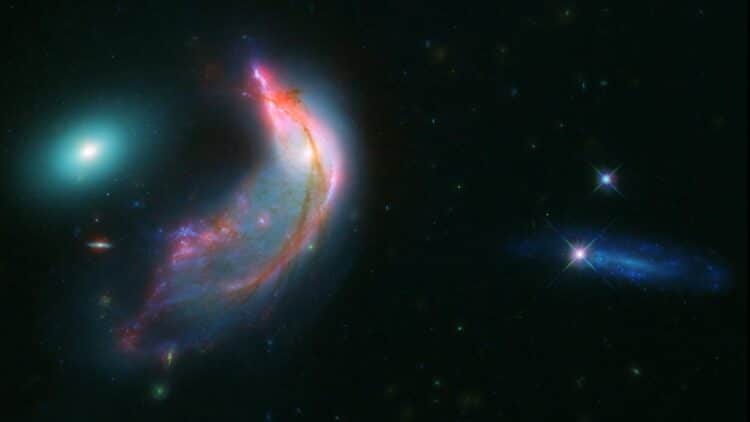As we gaze up at the night sky and see a seemingly still, almost static calm, the universe is in constant motion. Entire galaxies collide, transform, create new stars, and extinguish others, all in a gravitational ballet that occurs on scales so vast we can barely imagine. Added to all this, NASA recently released an image that reminds us of this in a visually powerful way: a portrait of two galaxies locked in a cosmic embrace. There’s “something” in this image that’s capturing the attention of scientists and enthusiasts around the world.
A cosmic waltz: Can a this galaxy teach us how stars are born?
This image was taken to celebrate the James Webb Space Telescope’s second year of operation, and the timing couldn’t be better. Right in the center of the photo is a distorted galaxy that, curiously, has earned the nickname Penguin, due to its resemblance to the bird. And, next to it, a smaller, oval galaxy, called Egg, completes the scene as if they were about to dance. And it’s not just appearance: they are actually moving around each other, interacting for tens of millions of years. The gravitational force that binds them has triggered an explosion of new stars.
As if all this weren’t already surprising, this dance has completely reshaped Penguin’s appearance. Its spiral arms were unraveled as if time were unraveling ribbons from a cosmic gift. Dust and gas were swept in various directions, and the galaxy today resembles a penguin with a head, eye, beak, and even a fanned tail. The Egg, however, remained intact, silent and stable, with old stars and little visible gas.
The cosmic photobomber: What can one uninvited galaxy reveal about the James Webb Telescope’s power?
Now, if you’ve had the opportunity to view the image, you were probably immediately mesmerized by the two main galaxies, and so you may have missed a rather curious “intruder” in the upper right corner. That’s where NASA spotted it: a bright, edge-on galaxy that looks like a party crasher. Cataloged as PGC 1237172, it’s not even part of the dance…
It’s 100 million light-years closer to Earth than Arp 142. But the depth of the image, captured by James Webb’s infrared cameras, is so incredible that it appears there as if it were in the same environment. And the best part is that even though it’s not the focus, this “penetrating” galaxy serves as a reminder of what Webb is capable of: capturing multiple layers of the universe in a single image, from “nearby” objects to galaxies so distant they appear as ghostly dots (it’s no wonder it discovered over 800,000 galaxies in the darkness).
Galactic experiments: Is the universe reshaping itself right before our eyes?
We need to keep in mind that interactions like this between Penguin and Egg aren’t just visually striking. This is because they help explain how galaxies evolve. In other words, when two galaxies of the same size meet, they don’t collide like cars; in fact, stars rarely collide. However, their orbits get messed up, gravity redistributes everything, and entire structures are rewritten.
Essentially, it’s as if the universe is experimenting with new possibilities of shape, color, and movement. And in this case, Penguin, despite appearing larger, has a similar mass to Egg, which is precisely why they haven’t merged yet. Now, when galaxies with very different masses meet, the smaller one is quickly absorbed, which isn’t our case right now. Deep in the image, we can see a vast array of other tiny, distant galaxies, barely visible. These are images from billions of years ago, when the universe was young. All of this in a single scene, frozen by the most advanced technology we have for observing the cosmos, Recently, James Webb researchers have bene announcing increasingly unimaginable discoveries.


